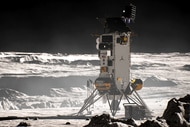With Gusto! NASA Launching Its Next Space Telescope on a Massive Balloon
We're all for more steampunk astronomy.

When humanity decided in the mid-20th century to put boots on the Moon, there were a lot of hurdles to overcome. The Earth’s atmosphere and gravity are usually selling points for our planet, but they are obstacles to space exploration. Moving Neil Armstrong, Buzz Aldrin, and Michael Collins a quarter of a million miles across space meant designing complex machines to keep them alive in the near-emptiness of space, but first they had to get off the ground. See the story behind the space race and the man behind the legend in Armstrong, streaming now on Peacock.
Getting off the ground requires overcoming the intense downward pull of the Earth’s gravity, and the scientists behind the mid-century space boom leaned on missile technologies to make that happen. When Apollo astronauts made their historic rides through space, they did so on the top of controlled explosives. Since then, every astronaut, satellite, and spacecraft we’ve deployed has launched atop a rocket. Now, scientists are readying to launch a brand-new aerial telescope from a research station in Antarctica using a balloon the size of a football field.
The GUSTO Telescope Is About to Lift Off Aboard a Huge Balloon
The project is called GUSTO (short for Galactic/Extragalactic ULDB Spectroscopic Terahertz Observatory) and it’s aiming to study the loose collection of mostly hydrogen between stars. The interstellar medium makes up most of the physical space in our galaxy but has only a small portion of the matter.
RELATED: What is This Cloud of Gas Bigger Than a Galaxy Doing All by its Lonesome?
The interstellar medium is where cold gas and dust hang out in vast molecular clouds which sometimes collapse into new stars and planets. By better understanding the interstellar medium, scientists hope to get a better handle on how star systems and galaxies evolve over time.
The GUSTO telescope plans to observe a 100 square degree area of our own Milky Way galaxy, creating a 3D map of the atoms and molecules in the interstellar medium. In particular, it’s on the hunt for emission signals from oxygen, carbon, and nitrogen in those loose interstellar clouds.
“We basically have this radio system that we built that we can turn the knob and tune to the frequency of those lines. And if we hear something, we know it's them. We know it's those atoms and molecules.” Chris Walker, principal investigator of GUSTO at the University of Arizona, said in a statement.
Here on Earth, water vapor in the atmosphere absorbs those faint emission lines, making it impossible to do this kind of research from the ground. Space-based telescopes like Hubble and JWST get around that problem by getting outside of the atmosphere. GUSTO will do the same thing but in a gentler way.
RELATED: Hubble and JWST Join Forces to Create Most Colorful View of the Cosmos Ever
The telescope will launch from the Ross Ice Shelf near the U.S. National Science Foundation’s McMurdo research station in Antarctica and ascend to about 120,000 feet on a gigantic balloon. That’s about as good as being in space for this sort of research, according to scientists.
The telescope is big, but the balloon is much bigger, clocking in at 39 million cubic feet when inflated, roughly the same diameter as a football field. GUSTO will lift off attached to a zero-pressure balloon, open at the bottom and sides to allow gas to escape. That design can prevent the balloon from being destroyed due to rapid expansion at high altitudes, but it also limits flight times because gas has to be replenished. Still, once GUSTO gets into the air, it will spend at least 55 days in flight, scoping out the distant parts of our galaxy through the rarified air of the thin Antarctic atmosphere.
That sounds a lot more peaceful than what Armstrong had to endure. Catch Armstrong, streaming now on Peacock.


























